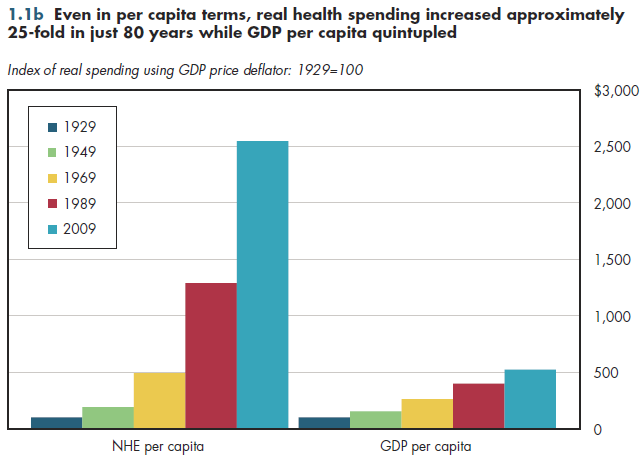Spending on health care in the United States has increased more than 60-fold since
1929.
This remarkable growth is measured in constant dollars that equalize general
purchasing power across decades. In contrast, the U.S. economy grew only 12-fold over the same period (figure 1.1a).

National health expenditures (NHE) and NHE per capita are the best available
single measures of the size of the health sector. NHE reflects the total amount of
spending on health care, including goods and services having to do with personal
health care, public health activities, public and private health insurance, related
investments in research, and capital investment. Both gross domestic product (GDP)
and NHE measure output only within the borders of the United States.
The U.S. population is approximately 2.5 times as large as it was in 1929. Even
when considering spending growth in per capita terms, inflation-adjusted health
spending was 25 times as large at the end of these 80 years as at the start. GDP
per capita quintupled (figure 1.1b). Does this mean that today’s average Americans
receive 25 times as much medical care as their counterparts did in 1929? It does not.
Figures 1.1a and 1.1b show how the total dollars spent on health care changed over
time, but the estimates shown are adjusted only for changes in general purchasing
power rather than purchasing power within the health sector. Devoting 25 times as
much real economic output to purchasing medical care is not equivalent to saying
that U.S. residents receive 25 times as much medical services (for example, physician
visits, hospital days) as they did in 1929.

The GDP implicit price deflator is the most comprehensive measure of pure
price inflation for the economy as a whole. The Consumer Price Index (CPI) is better
known but covers only approximately 60 percent of the economy, omitting rural
areas, government purchases, and investment goods. Because half of health spending
currently is publicly funded, it is more accurate to use a price index, such as the GDP
deflator, that broadly reflects the entire economy. Adjusting NHE by the GDP deflator
reflects the opportunity cost of health care, which measures how the total value of
other goods and services that society could have purchased instead of health care has
changed over time, while excluding a cause of growth—economy-wide inflation—
largely beyond the control of the health sector.
Download Excel tables used to create both figures:
Figures 1.1a/1.1b Tables.
Figures 1.1a and 1.1b both were created from the following table (the workbook includes all supporting tables used to create this table):
- Table 1.1. U.S. Total Real National Health Expenditures Using Alternative Price Deflators: 1929 to 2021
Download PowerPoint versions of both figures.
Note that the downloadable Excel tables contain a detailed description of methods and sources; the extensive references are not replicated here. Below are references cited in footnotes for this module.
- Centers for Medicare and Medicaid Services (CMS). 2011a. National Health Expenditures Accounts: Methodology Paper, 2011. Definitions, Sources, and Methods. Available at: http://www.cms.gov/Research-Statistics-Data-and-Systems/Statistics-Trends-and-Reports/NationalHealthExpendData/Downloads/dsm-11.pdf (accessed January 10, 2013).
- Centers for Medicare and Medicaid Services (CMS). 2011b. Quick Definitions for National Health Expenditure Accounts (NHEA) Categories. Available at: http://www.cms.gov/Research-Statistics-Data-and-Systems/Statistics-Trends-and-Reports/NationalHealthExpendData/Downloads/quickref.pdf (accessed January 10, 2013).
- Centers for Medicare and Medicaid Services (CMS), Office of the Actuary. 2012. National Health Expenditures by type of service and source of funds: CY 1960-2011. Last updated December 27, 2012. Available at: https://www.cms.gov/Research-Statistics-Data-and-Systems/Statistics-Trends-and-Reports/NationalHealthExpendData/Downloads/NHE2011.zip (accessed January 10, 2013).
- Cooper BS, NL Worthington and MF McGee. 1973. Compendium of National Health Expenditures Data. DHEW Pub No (SSA) 73-11903. Office of Research and Statistics.
- Hartman MB, RJ Kornfeld, and AC Catlin. 2010. A Reconciliation of Health Care Expenditures in the
National Health Expenditures Accounts and in Gross Domestic Product . Survey of Current Business, September 2010: 42-52. Available at: http://www.bea.gov/scb/pdf/2010/09%20September/0910_healthcare.pdf (accessed March 21, 2013).










